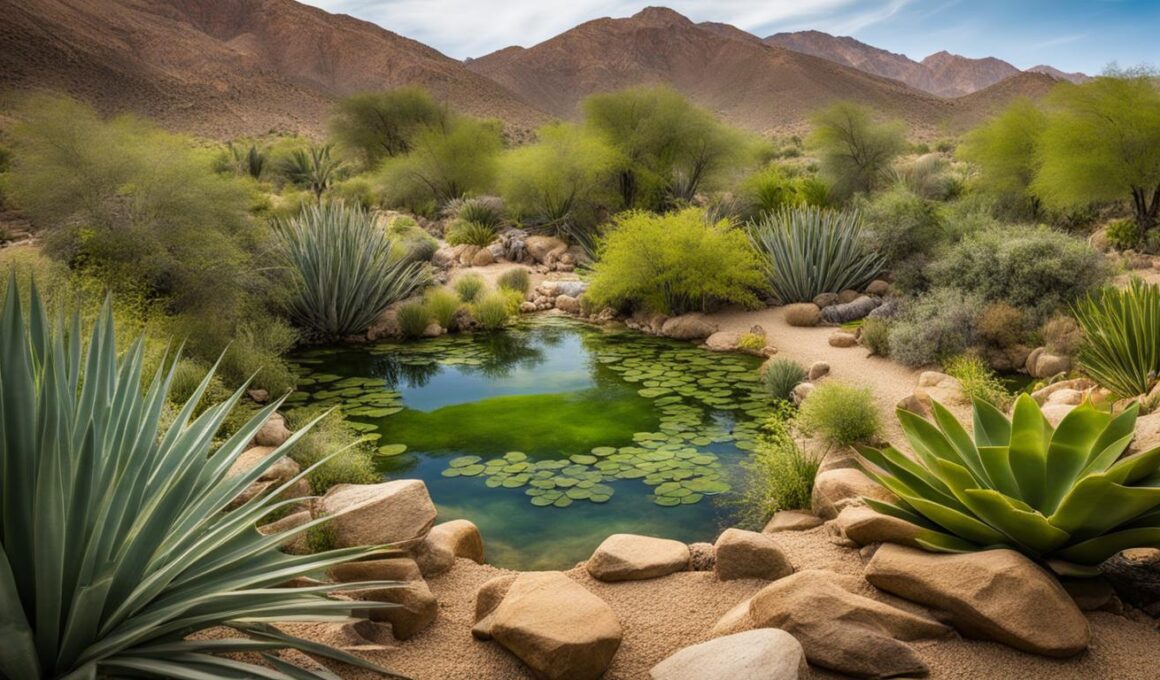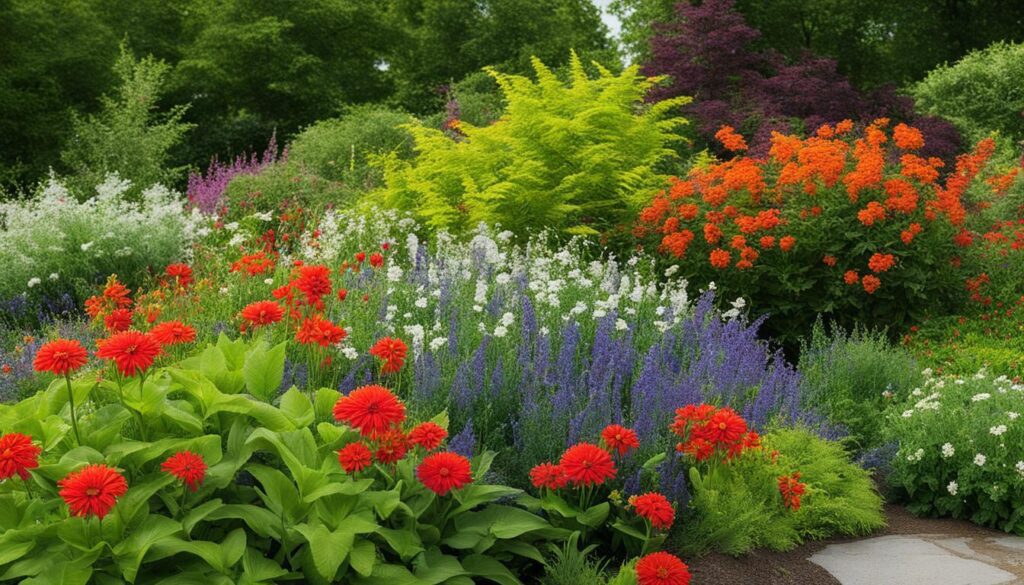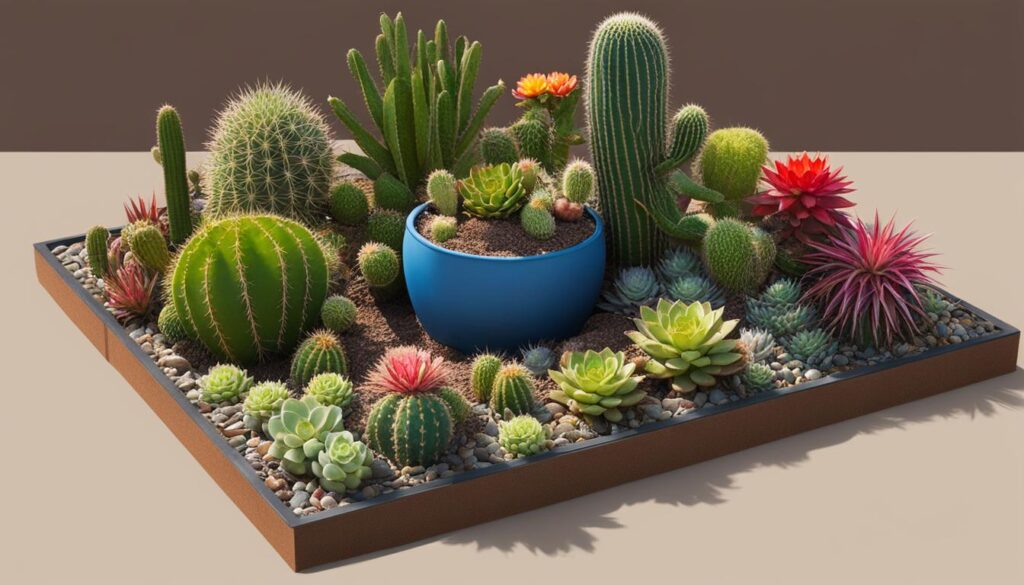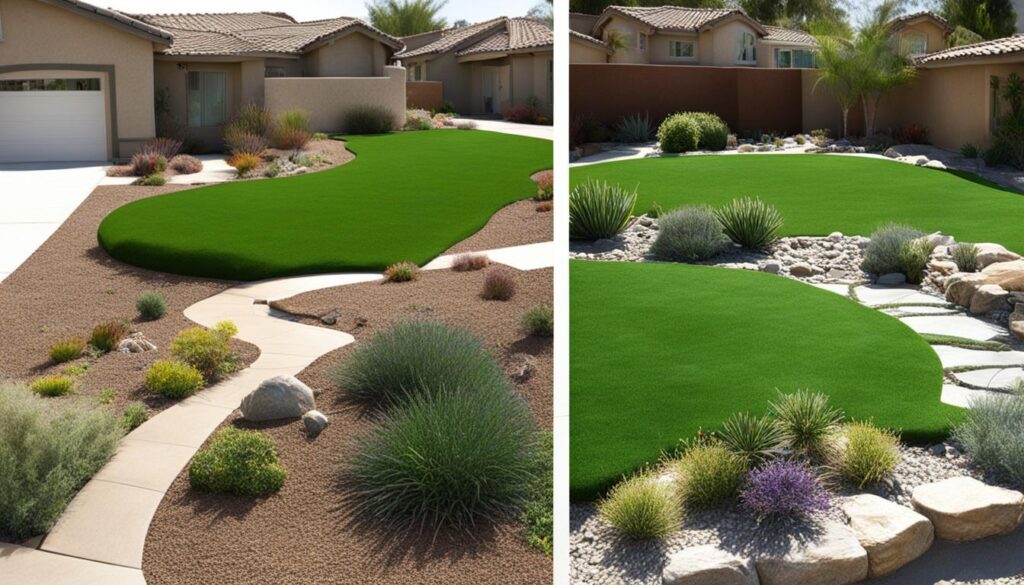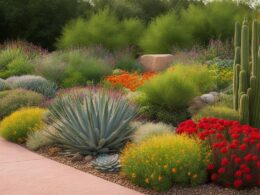Are you looking for effective water-saving techniques for your residential property? Consider xeriscaping, a method of landscaping that focuses on reducing water usage. Xeriscaping incorporates drought-tolerant plants, efficient irrigation systems, and other water-saving practices to help you conserve water, protect the environment, and beautify your landscape.
With increasing concerns about water scarcity and environmental impact, xeriscaping has become a popular choice for homeowners seeking sustainable landscaping solutions. By implementing xeriscaping principles, you can create a visually appealing and water-wise garden that thrives even in dry conditions.
Key Takeaways:
- Xeriscaping is a landscaping method that focuses on reducing water usage in residential areas.
- By using drought-tolerant plants, efficient irrigation systems, and other water-saving techniques, homeowners can conserve water and protect the environment.
- Xeriscaping follows seven key principles, including planning and design, efficient irrigation, mulching, soil preparation, appropriate turf selection, water-efficient plants, and proper maintenance.
- Choosing drought-tolerant native plants adapted to local climates is crucial for successful xeriscaping.
- Implementing water conservation practices such as efficient watering, mulching, and plant grouping can significantly reduce water usage in xeriscaped landscapes.
Understanding the Impact of Droughts on Plants
Droughts can have a significant impact on plants, causing various symptoms of drought stress. When plants experience a lack of water, they can exhibit wilting, leaf scorch, and even die off. The limited water availability affects their ability to carry out essential functions, such as photosynthesis and nutrient uptake. These effects weaken the overall health and resilience of plants, making them more susceptible to pests and diseases.
Recognizing the symptoms of drought stress is crucial in identifying when plants need water and implementing appropriate water conservation measures. By closely monitoring your plants and observing signs like drooping leaves, brittle stems, and discolored foliage, you can take action to alleviate their stress.
“When plants are in a drought-induced stress state, you’ll notice changes in their appearance and behavior. They may have smaller leaves, show signs of wilting, or exhibit a slower growth rate,” says horticulturist Dr. Emily Williams.
Water conservation in plants is not only important for their survival but also for the overall sustainability of our environment. By understanding how drought impacts plants and recognizing the symptoms of drought stress, you can take proactive measures to conserve water and protect the health of your landscape.
Xeriscaping Principles: Creating a Water-Wise Landscape
When it comes to xeriscaping, there are seven key principles that guide the creation of a water-wise landscape. These principles not only help conserve water but also promote the health and beauty of your outdoor spaces. By incorporating these principles into your landscape design and maintenance, you can create a sustainable and visually appealing garden that thrives in dry conditions.
1. Planning and Design:
Before starting your xeriscaping project, take the time to plan and design your garden. Consider factors such as sun exposure, soil type, and water availability. Utilize hardscapes, such as rocks and gravel, to create visually pleasing elements that require little to no water. Design your outdoor space in a way that optimizes water usage and minimizes runoff.
2. Efficient Irrigation Systems:
Implementing efficient irrigation systems is essential for xeriscaping. Drip irrigation, for example, delivers water directly to the roots of plants, minimizing evaporation and ensuring efficient water usage. Installing smart irrigation controllers can also help adjust watering schedules based on weather conditions, further reducing water waste.
3. Mulching:
Mulching plays a crucial role in xeriscaping by conserving soil moisture and reducing weed growth. Applying a layer of organic mulch, such as wood chips or bark, helps retain moisture in the soil, reducing the frequency and amount of watering required. Mulching also improves soil health and prevents erosion.
4. Soil Preparation:
Preparing the soil before planting is key to success in xeriscaping. Enhancing soil quality with organic matter, such as compost, improves water retention and promotes healthy root growth. Well-prepared soil allows plants to access water more efficiently, reducing the need for frequent watering.
5. Appropriate Turf Selection:
Xeriscaping promotes the use of drought-tolerant turf varieties or minimizing turf areas altogether. Consider alternatives to traditional turf, such as low-growing groundcovers, ornamental grasses, or native plants, which require less water and maintenance.
6. Water-Efficient Plant Choices:
Choosing water-efficient plants is essential for xeriscaping. Opt for native or adapted plant species that are well-suited to your climate and require minimal irrigation. These plants have evolved to thrive in local conditions and can withstand periods of drought without compromising their beauty.
7. Proper Maintenance:
Regular maintenance is crucial for a successful xeriscape garden. Proper pruning, weed control, and monitoring irrigation systems ensure optimal water usage and plant health. Pay attention to plant needs, adjusting watering schedules based on seasonal changes and weather conditions.
Incorporating these principles into your xeriscaping project will help conserve water, reduce maintenance requirements, and create a beautiful and sustainable landscape. With a water-wise garden, you can enjoy lush greenery while minimizing your environmental impact.
Choosing Drought-Tolerant Native Plants for Xeriscaping
When it comes to xeriscaping, selecting the right plants is crucial for creating a water-wise and visually stunning landscape. Drought-tolerant native plants are excellent choices as they are adapted to local climates and require less water. In Maryland, there are several options that thrive in dry conditions and can handle limited water availability.
“Native plants are the backbone of any successful xeriscape garden. Not only do they bring beauty and biodiversity to your landscape, but they also have natural adaptations to dry conditions, making them perfect for water-wise gardening.” – Landscaping expert
Some examples of drought-tolerant native plants in Maryland include:
- Northern Bayberry: This evergreen shrub is known for its aromatic leaves and berries. It is highly adaptable and requires minimal watering.
- Adam’s Needle Yucca: With its striking foliage and tall flower spikes, this plant adds a dramatic touch to any xeriscape garden. It can withstand drought and thrives in well-drained soil.
- Butterfly Weed: As the name suggests, this plant attracts butterflies with its vibrant orange flowers. It is heat and drought tolerant, making it an excellent choice for xeriscaping.
- Coreopsis: This cheerful perennial produces bright yellow flowers and is known for its ability to thrive in dry, sunny conditions. It requires little water once established.
By incorporating these drought-tolerant native plants into your xeriscape garden, you can create a beautiful and sustainable landscape that conserves water and supports local ecosystems.
Implementing Water Conservation Practices in Xeriscaping
Implementing water conservation practices in xeriscaping is essential for maximizing the efficiency of your irrigation system and minimizing water waste. By incorporating these practices into your landscape design and maintenance, you can create a visually appealing and sustainable environment that conserves water. Here are some key water conservation practices to consider:
1. Efficient Watering
Efficient watering is crucial in xeriscaping to ensure that plants receive the right amount of water without wastage. Consider installing drip irrigation systems or using soaker hoses to deliver water directly to the plant roots, reducing evaporation and runoff. Additionally, watering your plants during the early morning or evening hours when temperatures are cooler can help minimize water loss due to evaporation.
2. Mulching
Mulching is an effective technique to retain soil moisture and suppress weed growth in xeriscaping. Apply a layer of organic mulch, such as wood chips or bark, around your plants to help prevent water evaporation and keep the soil cool. Mulching also improves soil structure, reduces erosion, and adds nutrients to the soil as it breaks down.
3. Plant Grouping
Grouping plants with similar watering needs is a smart strategy in xeriscaping. By creating hydrozones, where plants with similar water requirements are grouped together, you can avoid overwatering or underwatering certain areas. This ensures that each plant receives the appropriate amount of water, reducing water waste and promoting plant health.
By implementing these water conservation practices in xeriscaping, you can significantly reduce water usage in your residential landscape. Efficient watering, mulching, and plant grouping are just a few of the techniques that can help you create a sustainable and visually appealing environment while conserving water resources.
References:
- “Efficient Watering Practices for your Landscape.” University of California. Accessed August 15, 2022. https://ucanr.edu/sites/scmg/files/94789.pdf
- “Mulching.” Colorado State University Extension. Accessed August 15, 2022. https://extension.colostate.edu/topic-areas/yard-garden/mulches-for-home-grounds-7-214/
- “Water-Wise Planting Tips.” Save Our Water. Accessed August 15, 2022. https://saveourwater.com/outdoor-tips/planting-tips/
The Cost and Benefits of Xeriscaping
Xeriscaping offers a range of financial benefits in addition to its positive impact on water conservation. While the initial cost of implementing xeriscaping may vary depending on factors such as the size of the area and plant selection, experts estimate an average cost of $1.50 to $2.50 per square foot for residential properties. This upfront investment includes the cost of drought-tolerant plants, efficient irrigation systems, and other necessary materials. However, the long-term financial savings can make xeriscaping a worthwhile endeavor.
By embracing xeriscaping techniques, homeowners can save approximately 36 cents per square foot annually on water bills. With xeriscaping reducing water usage by 50% to 75%, these savings can quickly add up over time. Not only does this result in a lower monthly water bill, but it also contributes to the conservation of water resources and reduces the strain on local water supplies. Xeriscaping allows you to enjoy a visually appealing landscape while simultaneously saving money and promoting environmental sustainability.
Furthermore, xeriscaping has the potential to increase the value of your property. Many homebuyers are increasingly interested in eco-friendly, water-efficient features, and xeriscaped gardens can be an attractive selling point. A well-maintained and thoughtfully designed xeriscape can enhance the curb appeal of your home and set it apart from others on the market. By investing in xeriscaping, you are not only benefiting from reduced water expenses but also potentially increasing the overall value of your property.
Key Financial Benefits of Xeriscaping
- Significant long-term water savings
- Reduced water bills by approximately 36 cents per square foot annually
- Lower overall water usage by 50% to 75%
- Potential increase in property value
- Attractive selling point to eco-conscious homebuyers
Investing in xeriscaping not only saves you money on water bills and maintenance but also offers an opportunity to contribute to a more sustainable future.
By considering the cost and benefits of xeriscaping, you can make an informed decision about implementing this water-saving landscaping technique. With the potential for long-term financial savings, increased property value, and positive environmental impact, xeriscaping provides an attractive solution for homeowners looking to conserve water and create beautiful, sustainable landscapes.
How Does Xeriscaping Help in Residential Water Conservation Compared to Traditional Landscaping?
Xeriscaping vs traditional landscaping can significantly reduce residential water usage. Xeriscaping, with its emphasis on drought-tolerant plants and efficient irrigation, minimizes water waste and promotes sustainability. In contrast, traditional landscaping often relies on high-water plants and inefficient watering systems, contributing to excessive water consumption.
Conclusion
Residential water conservation through xeriscaping is a smart and sustainable solution for homeowners to save water, protect the environment, and create stunning landscapes. By implementing the principles of xeriscaping, you can significantly reduce your water usage, minimize wastage, and lower your utility bills. With the added benefit of requiring minimal maintenance, xeriscaping allows you to enjoy a beautiful garden while conserving water resources.
By embracing xeriscaping, not only do you benefit personally, but you also contribute to the overall conservation of water resources and promote environmental sustainability. By using drought-tolerant native plants, efficient irrigation systems, and water-wise practices, you can play an active role in ensuring a greener and more water-conscious future.
So, if you’re looking for a way to create a sustainable landscape that offers long-term cost savings and benefits, xeriscaping is the ideal choice. With its focus on residential water conservation, xeriscaping not only helps preserve our precious water resources but also enhances the beauty of your outdoor space. So go ahead and start your xeriscaping project today to enjoy the rewards of a water-wise and environmentally-friendly landscape.





